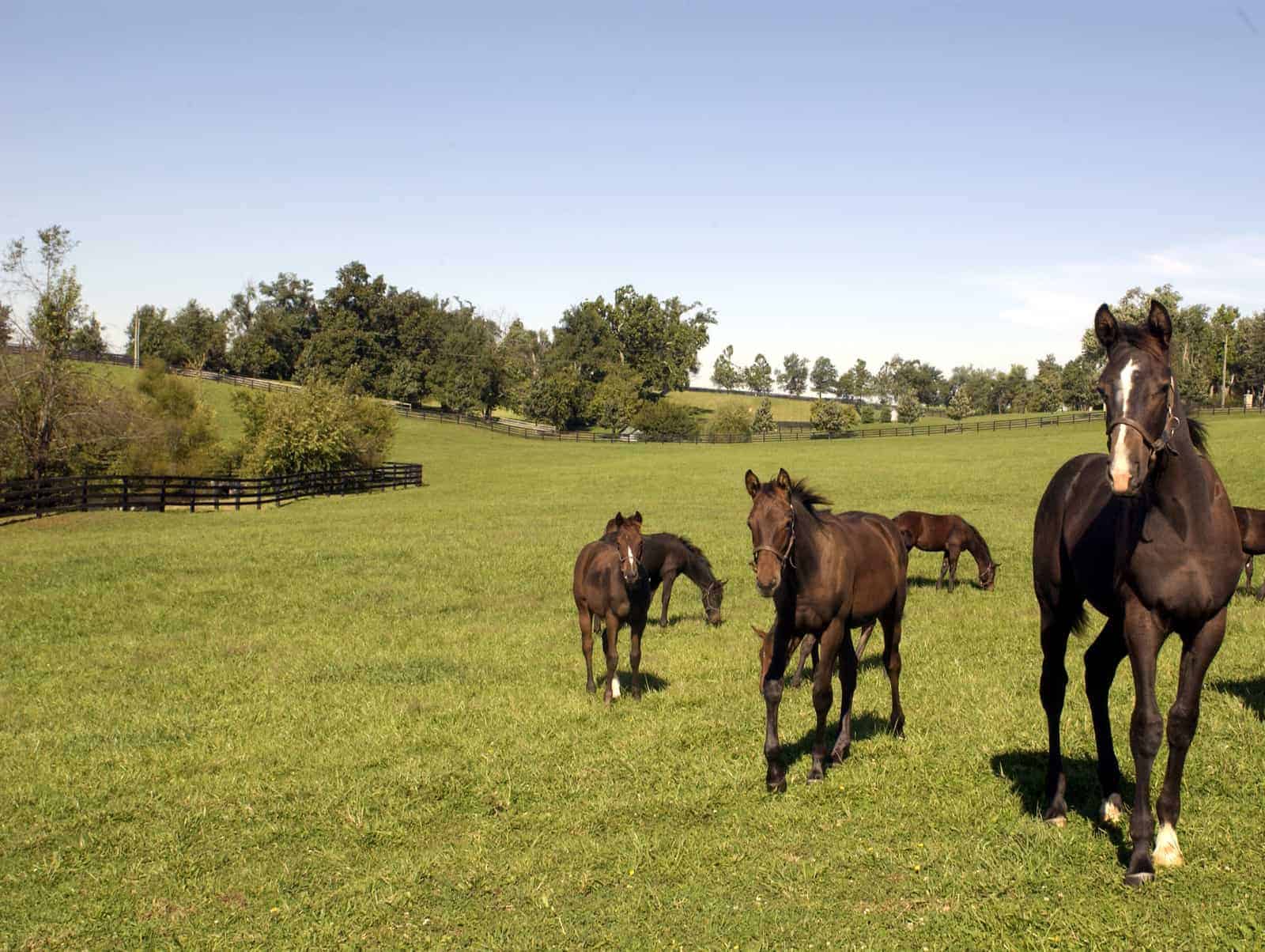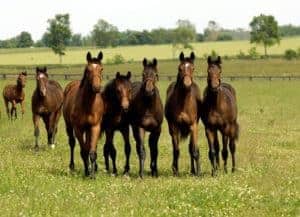Weaning Ways

Here’s how to help your weanling transition to adulthood as smoothly as possible
Weaning can be an exciting time for you to introduce your young horse to new things without his dam by his side. You get to watch his personality and intellect develop, while catching a glimpse of his potential for future athletic endeavors. But for the weanling, it might just be one of the most stressful times in his life. To help make this critical period in a young horse’s life go smoothly, Amanda Adams, PhD, of the University of Kentucky’s Gluck Equine Research Center, and Sarah Ralston, VMD, PhD, of Rutgers University’s Department of Animal Science, share their weaning tips.
When and How to Wean Foals
Selecting the appropriate weaning time for each foal is very important; you can”t just pick a convenient date on the calendar for the split. Our sources suggest weaning no earlier than four months of age, to allow the foal ample time to grow and develop a strong immune system before leaving mom’s side. “Based on research conducted in swine/bovine, early weaning has deleterious effects on weight gain and immune function, and this is likely the case if foals are weaned too early,” Adams says.
Likewise, how you wean your foal impacts his stress level. Adams and Ralston note that gradual weaning, or removing one broodmare from a mare and foal herd at a time, is less stressful for the foal than abrupt weaning, or separating the entire herd of mares from the foals cold turkey.
Another method involves turing nonrelated mares out with foals at the time they are weaned. In 2006 French researchers concluded that this approach reduced behavioral as well as physiological stress, with foals exhibiting less vocalization and aggression and better social cohesion. In addition, the adult-weaned foals secreted lower levels of the stress hormone cortisol in their saliva over the first four days post-weaning than their peer-weaned counterparts. Adams says scientists believe cortisol contributes to a suppressed immune system response during and after weaning.
Ralston suggests turning weanlings out with a well-behaved gelding or nonrelated mare both for companionship and for teaching them how to behave.
Weaning is a great time to emphasize good ground manners, such as leading well, picking up feet readily, and standing for grooming and baths. Adams and her colleagues get each foal used to human handling by interacting with him at his dam’s side.
It’s also a good time for new exposures and experiences. “Here at Rutgers we had a course jokingly called the Gauntlet of Terror that we trained the weanlings to be led through,” Ralston says. “It included everything from plastic bags and umbrellas to a silly talking bird toy. When we sold them as yearlings, they were pretty unflappable thanks to all the handling they received.”
But properly preparing a foal for his independence from mom isn’t just about timing, herd dynamics, and handling. “Before you wean, be sure that you have introduced foals to the new diet they will be eating after they are weaned,” Adams says. “I like to introduce new dietary factors around a month prior to weaning.”
Feeding Weanlings
Ralston’s primary advice for selecting weanling diets is to keep it simple. Weanlings need a steady nutritional plane, she explains, and should not be undernourished or overfed, as either extreme can lead to developmental issues.
“It’s important to feed a good alfalfa or legume-based forage to give the horses their protein and calcium, and then figure in any grain to provide other minerals and extra energy if needed,” Ralston continues. “The old fear of (feeding weanlings) excess protein has been proven repeatedly to be false. The real danger is overfeeding energy, especially carbohydrates, with inadequate mineral intake.”
Too much energy promotes rapid development at a time when foals are already growing like weeds (particularly from 4 to 6 months old). “We had Draft-cross weanlings gaining over one pound a day and growing 3/4 to 1 inch in height every week or two,” Ralston says. “If their nutrition is imbalanced (i.e., too much energy and not enough protein or minerals), problems such as epiphysitis (growth plate inflammation), poor bone growth, and flexural deformities will show up and progress very quickly. So if you start to see issues, don’t wait—reassess your feeding program or call in a nutrition specialist ASAP. You want to nip those issues in the bud.

“In my experience, many horse owners are underfeeding minerals, especially calcium and phosphorus,” Ralston continues, which she describes as building blocks to an ideal diet. “If you do feed a concentrate, make sure it is formulated specifically for growth, with added calcium, phosphorus, and trace minerals such as copper and zinc.”
Adams underscores the importance of introducing the new diet slowly, starting with the good-quality forage and gradually adding and increasing the amount of concentrate as necessary. Creep feeding (offering a commercial concentrate formulated for foals, separate from the mare) and ahead of weaning helps introduce this new diet without the foal having to compete with the mare. “In fact, creep-fed foals cope better with weaning stress and have less weight loss during weaning,” she says.
The bottom line with nutrition, says Ralston, is to reach a happy medium. “You don’t want the foals to be too fat or too thin,” she says. “You don’t want to see their ribs, but you do want to be able to feel them. If they are getting adequate nutrition their coats will have a natural shine to them, and they should be active, playful, and alert.”
Immune Suppression During Weaning
Researchers have studied immune suppression in species such as cattle and hogs, but until recently discussion about the effects of stress on horses’ immune response has been purely anecdotal. Amanda Adams, PhD,of the University of Kentucky’s Gluck Equine Research Center, has been studying immune response suppression during weaning for the past three years.
—Connie Lechleitner
Managing Exercise and Monitoring Changes
Weanlings thrive on as much turnout as possible. “Don’t keep them in a stall all the time—they need the exercise,” Ralston says. “But keep in mind, if they can find trouble, they will. Be prepared to have a few scrapes (don’t worry, they will heal). The ability to run around is much more important for their development.” And again, an older horse can help keep them company and serve as a role model.
In addition to cuts and scrapes, watch for any sort of abnormal swelling around a weanling’s joints, changes to fetlock or knee angles, abnormal leg contours, or signs of being over at the knee, lame, or lethargic. “These are warning signs (of musculoskeletal issues), and you need to get help as soon as possible,” Ralston says.
Adams’ greatest concern during weaning is the foal’s immune system. “My own research, as well as others, has shown that stress causes the immune system to become suppressed during weaning,” she says (see sidebar). “Our research shows the immune response remains compromised for a pretty long window—21 days. This likely makes them more vulnerable and more susceptible to respiratory and GI infections.”
For this reason she recommends keeping recently weaned herds “clean” and practicing smart biosecurity: “Don’t house weanlings where you will have horses coming and going from your farm,” Adams says. “You want to minimize their exposure to anything new. Even have your handlers be sure to follow biosecurity and safety rules so that they do not bring anything new to your farm.”
Monitor your foals closely throughout the 21-day period. Look for signs that something’s wrong: Foals that are off their feed, appear lethargic or dull, or that develop a snotty nose or diarrhea require veterinary attention, Adams says.
“We also watch closely for signs of respiratory or other infections and take rectal temperature on any foal that seems ‘off,’ ” she adds. “Sick foals need to be removed from the herd as quickly as possible, because an infection can quickly spread through the whole herd.”
Behaviors such as increased vocalization and locomotion (and a resulting increase in heart rate), on the other hand, are normal post-weaning.
Take-Home Message
Although the process can be stressful, our sources assure us that weaning can be managed successfully with advance planning, good nutrition, and close observation. Work with your veterinarian and equine nutritionist to develop an individualized weaning plan for your foal.
Written by:
Connie Lechleitner
Related Articles
Stay on top of the most recent Horse Health news with












